A PIR motion sensor alarm is a device which detects the infrared radiation from a moving human body and triggers an an audible alarm.
In this post I have explained 5 simple motion detector circuits using op amp and transistor. We also discuss the pinout details of the standard passive infrared (PIR) sensor RE200B.
We will Learn:
- How to use a PIR sensor device to Detect human body infrared.
- How to use a PIR module as a Security Burglar Alarm Circuit
- How to use a PIR to switch ON lights when a human presence is detected.
- How to apply a PIR to detect an object in industrial applications
The first circuit uses an op amp, while the second design works with a single transistor and relay for detecting the IR radiation from a moving human body and activating the a relay activated alarm.
What is a PIR
PIR is the acronym for Passive Infra Red. The term "passive" indicates that the sensor does not actively take part in the process, meaning it does not itself emit the referred infra red signals, rather passively detects infrared radiations emanating from warm blooded animal in the vicinity.
The detected radiations are converted into an electrical charge proportional to the detected level of the radiation. This charge is then further enhanced by the built-in FET and fed to the output pin of the device which becomes applicable to an external circuit for further amplification and for triggering the alarm stages.
PIR Pinout Details
The image shows a typical PIR sensor pinout diagram. It's quite simple to understand the pinouts and one may easily configure them into a working circuit with the help of the following points:

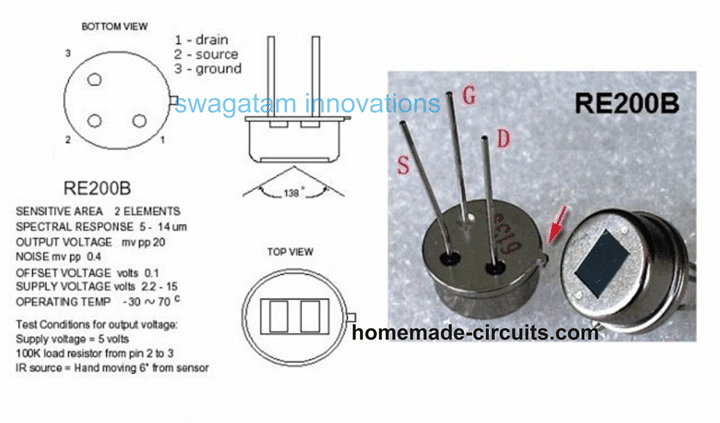
Technical Specifications of the PIR Sensor
- Sensor Type: Passive Infrared (PIR) sensor element.
- Sensitive Area: 2 elements.
- Spectral Response: 5 µm to 14 µm (infrared wavelength range).
- Output Voltage: Millivolt-level signal (0.4 mV pp typical).
- Offset Voltage: 0.1 volts (typical).
- Supply Voltage: 2 to 15 volts.
- Operating Temperature: -30°C to +70°C.
- Field of View (FOV): 138°.
Connections:
- Pin 1: Drain.
- Pin 2: Source.
- Pin 3: Ground.
Test Conditions for Output Voltage:
- Supply voltage: 5 volts.
- 100k load resistor from pin 2 to pin 3.
- Infrared source: Hand moving 6 inches from the sensor.
Pinout Details
As indicated in the following diagram, PIN#3 of the sensor should be connected to the ground or the negative rail of the supply.
Pin#1 which corresponds to the "drain" terminal of the dvice should be connected to the positive supply, which must be ideally a 5V DC.
And pin#2 which corresponds to the "source" lead of the sensor must be connected to ground via a 47K or 100K resistor. This pin also becomes the output pin out of the device and the detected infrared signal is carried forward to an amplifier from pin#2 of the sensor.
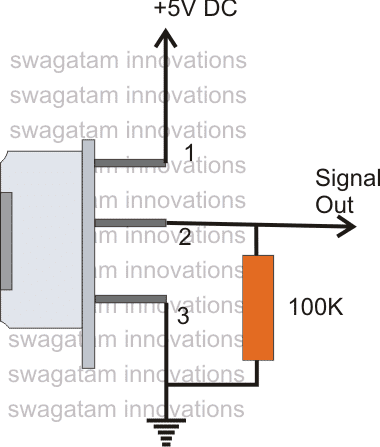
1) PIR Human Movement Detector Circuit using Op Amp
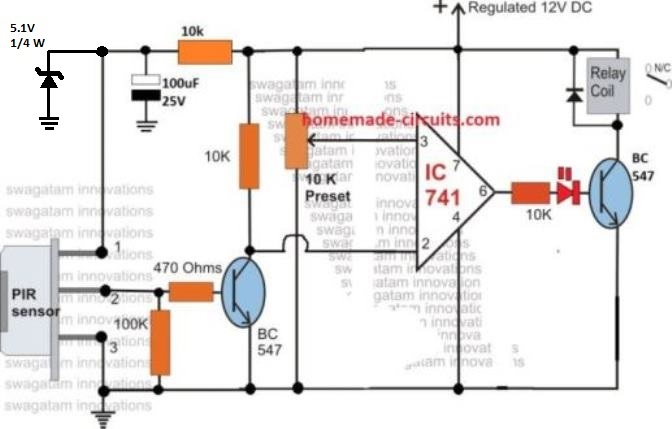
In the above section I have explained the datasheet and the pinouts of a standard PIR sensor now lets' move on and study a simple application for the same:
The first PIR circuit diagram for sensing moving humans is shown above. A practical implementation of the explained pin-out details can be witnessed here.
In the presence of a human IR radiation, the sensor detects the radiations and instantly converts it into minute electrical pulses, enough to trigger the transistor into conduction, making its collector go low.
The IC 741 has been set up as a comparator where its pin#3 is assigned as the reference input while pin#2 as the sensing input.
The moment the collector of the transistor goes low, the potential at pin#2 of the 741 IC becomes lower than the potential at pin#3. This instantly makes the output of the IC high, triggering the relay driver stage consisting of the another BC547 transistor and a relay.
The relay activates and switches ON the connected alarm device.
The capacitor 100 uF/25 V makes sure that the relay remains ON even after the PIR is deactivated possibly due the exit of the radiation source.
The PIR device discussed above is actually a core sensor and can be extremely sensitive and difficult to optimize. In order to stabilize its sensitivity the sensor should be suitably enclosed inside a Fresnel lens cover, this will additionally enhance the radial range of the detection.
If you are unsure about using an uncovered PIR device, you can simply go for a readymade PIR module with a lens and other enhancements, as described below.
Calculations
PIR Sensor Output Voltage Range:
The PIR sensor (RE200B) gives out about 0.4 mV (peak-to-peak) when it senses movement.
To connect it to the op-amp comparator you might need to boost this signal to a level that can be detected using a BJT preamplifier.
If we use an amplifier that increases the signal by 1000 times, the new amplified signal will be:
Vout_PIR = 0.4 mV × 1000 = 0.4 V (peak-to-peak).
Comparator Circuit Design:
Use an op-amp like LM358 as a comparator.
Reference Voltage (Vref): Choose a reference voltage slightly higher than the ambient noise level. For example:
Vref = 0.2 V.
Connect the amplified PIR sensor output to the non-inverting input (V+) of the op-amp.
Apply the reference voltage to the inverting input (V-).
Comparator Output Logic:
When V+ > V- (PIR detects motion), the op-amp output goes high (Vout = Vcc).
When V+ < V-, the op-amp output goes low (Vout = 0).
Relay Triggering:
Use the op-amp output to drive the relay through an NPN transistor (e.g. BC547).
Calculate the base resistor (Rb) for the transistor.
Assume:
- Relay coil voltage (Vrelay): 12V.
- Relay coil current (Irelay): 50 mA.
- Transistor current gain (hFE): 100.
- Op-amp output voltage (Vop): 5V.
Base current (Ib):
Ib = Irelay / hFE
= 50 mA / 100
= 0.5 mA.
Base resistor (Rb):
Rb = (Vop - Vbe) / Ib
= (5 - 0.7) / 0.5 mA
= 4.3 kΩ.
Choose Rb = 4.7 kΩ (nearest standard value).
Power Supply Requirements:
PIR Sensor: 5V supply.
Op-Amp: 5V supply (ensure it is within the op-amps operating range).
Relay: 12V supply (use a separate supply with a flyback diode across the relay coil to protect against voltage spikes).
Flyback Diode:
Use a diode like 1N4007 across the relay coil.
Ensure the diodes reverse voltage rating is greater than the relay supply voltage (e.g 12V).
2) PIR Motion Detector and Security Alarm Circuit
The following PIR motion sensor circuit can be easily built using the following basic set up and applied as a anti-theft alarm circuit.
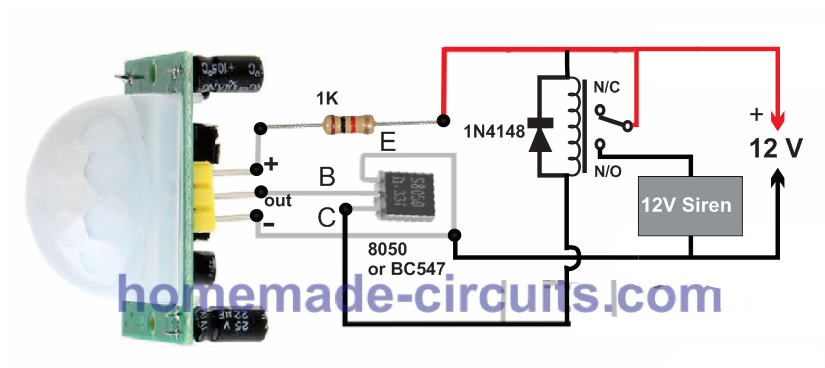
As the figure shows, the PIR only requires a single 1K resistor, transistor and a relay to be configured externally. The siren can be either built at home or purchased ready made.
The 12v supply can be from any ordinary 12V 1 amp SMP circuit.
Video Demo
3) Human Presence Detector using Two PIR Modules
The above explained PIR motion detector circuit can be also built using 2 PIR sensors in parallel for a 360 degree human presence detection.
This idea was tried and tested successfully by Mr. V.
Th device was installed above one of the door entrances for illuminating the passage automatically whenever a human approach was detected by the PIR sensors.
The following amazing circuit diagram and the tested prototype images were contributed by Mr. V.
Let's have a look at them.
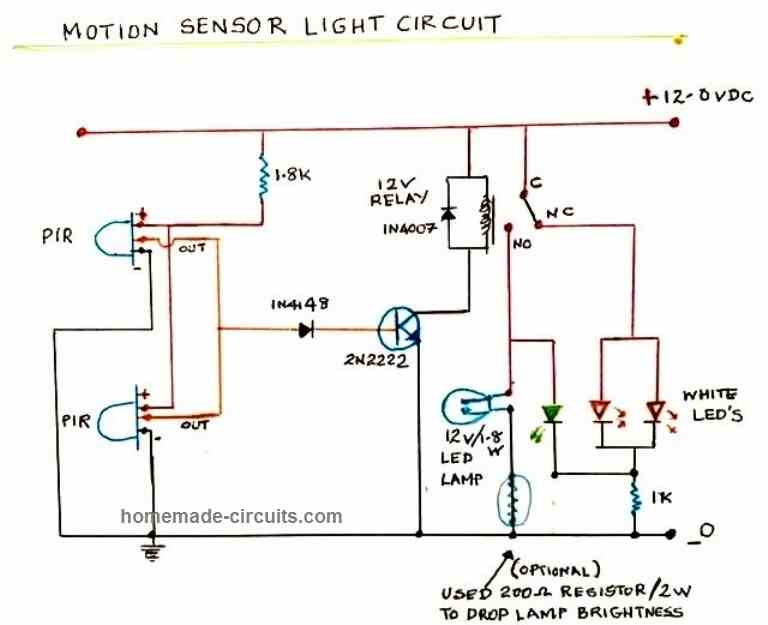
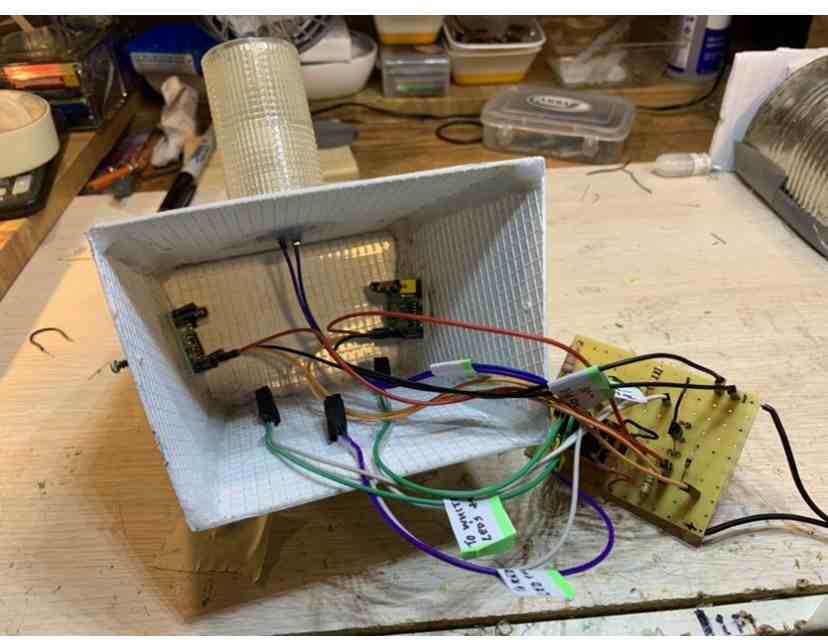
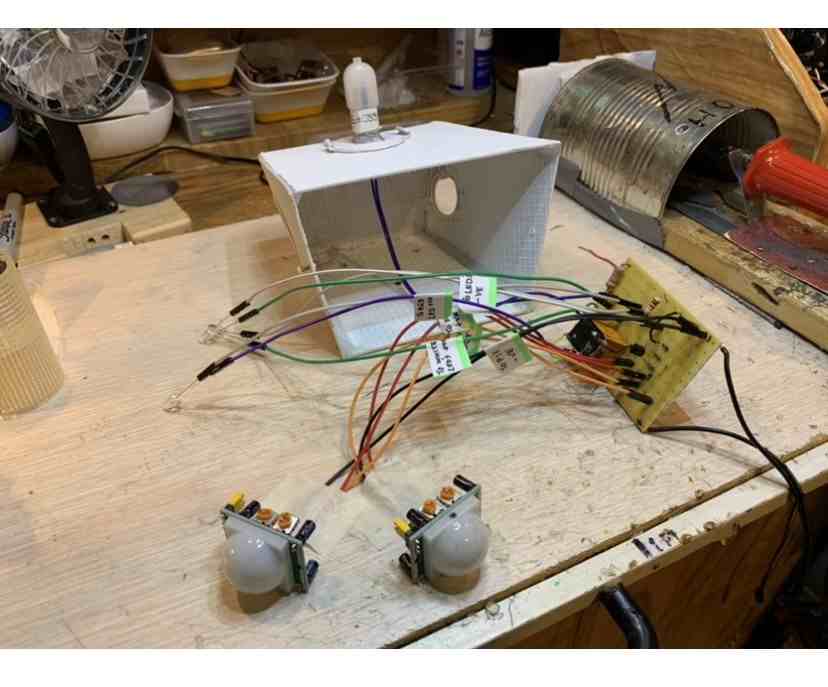
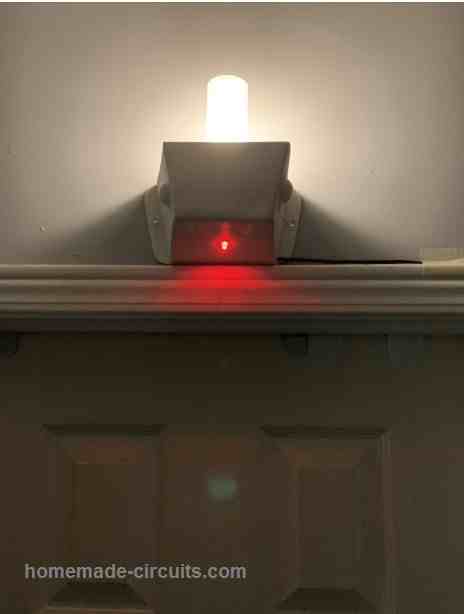
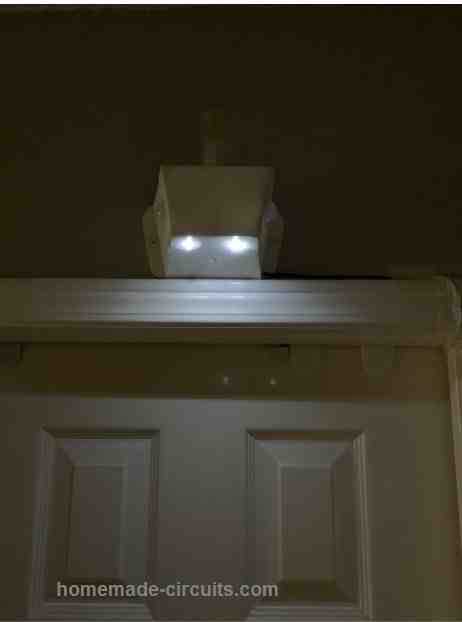
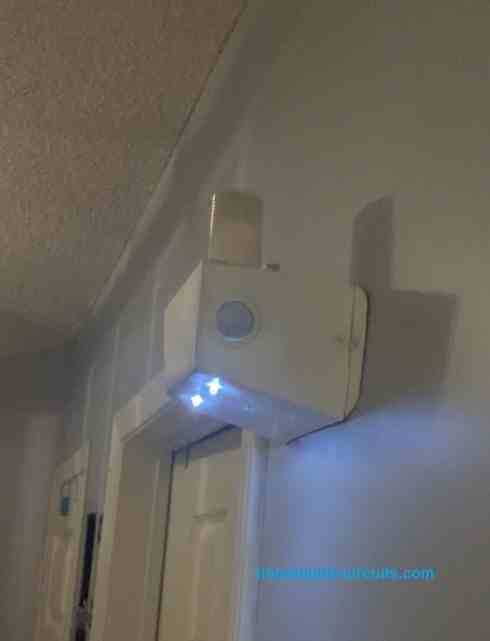
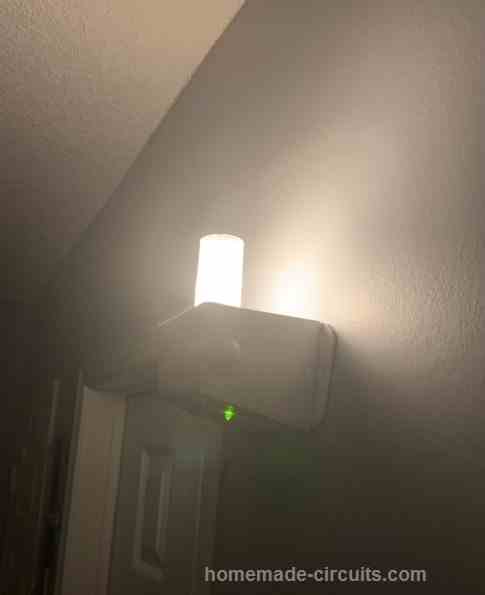
How to increase the Range of the PIR
The following information was sent by Mr. V. Hope this will help the users to adjust the range of the PIR to its maximum capacity.
Just this bit of info, I was playing around with the PIR Sensitivity Potentiometer and I realized it practically that if you turn the adjustment clockwise the sensitivity & Range increases, unlike what is given in the product description, it says turn Counterclockwise for max sensitivity. I tried it gradually in different positions & with it turned to about the 3 O’clock position, clockwise I get a Range of about 16 feet. I did not go max.
However the PIR should not be in an area with very bright light as it becomes unstable, it should be guarded or shaded from bright light.
Hope this was helpful,I did a check on 5 pieces & all responded the same way, I was very disappointed with the Range earlier now I’m happy. The timer pot is good, keeps to time set.
4) Another Simple PIR Based Alarm Circuit
The fourth idea below explains a simple PIR motion detector alarm circuit which can be used for activating lights or an alarm signal, only in the presence of a human or an intruder.
How it Works
Here is a simple circuit that activates a relay alarm when a living being (a human) is detected by the PIR sensor. Here PIR stands for Passive Infrared sensor. It doesn’t produce any infrared radiations to detect the presence of a living being but on the other hand it detects the infrared radiations released by them.
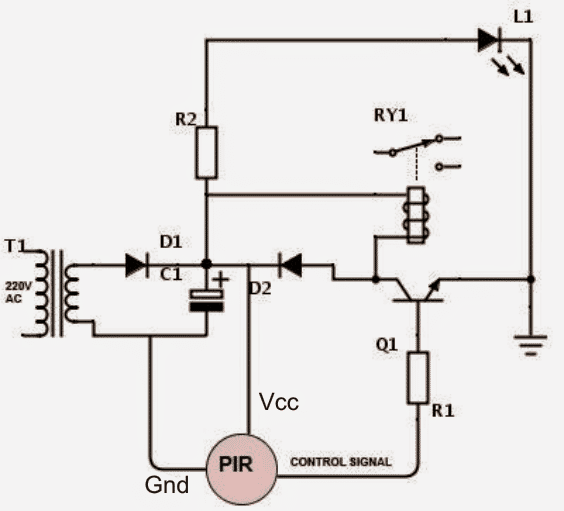
This circuit uses a HC-SR501 IC which is the heart of the circuit. Initially when the moving object is detected by the sensor, it produces a small signal voltage(usually 3.3 volts) which is fed to the base of the transistor BC547 through a current control resistor and hence, its output goes high and it switches the relay on.
A more Comprehensive Diagram can be Visualized below:
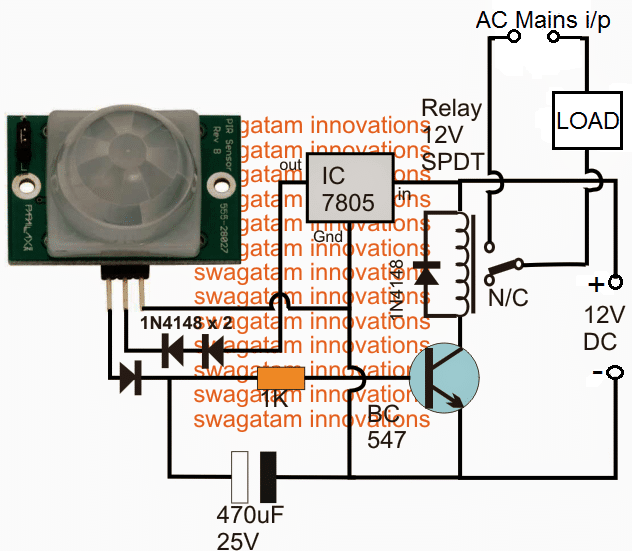
Relay Wiring
This relay can be configured to be used with a electrical bulb or a tubelight, night lamp or anything else that works on 220VAC.
This circuit is mostly used in gardens, so that at night, when we go for a walk in the garden, the circuit switches on a light automatically and it remains lit until we are in the sensor’s vicinity and it gets turned off when we move away from that place and hence reducing the electricity costs.
Here’s a back view of the sensor HC-SR501…
HC-SR501 Pinouts
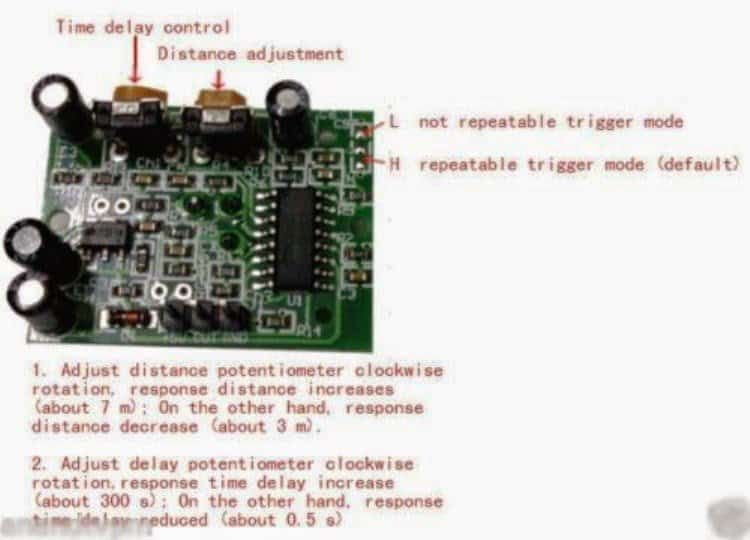
PIR Sensor Front View:
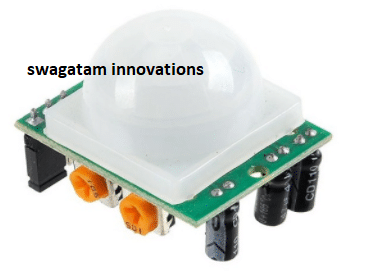
The sensor consists of two preset resistors which can be used to control the delay time and sensing range.
The delay potentiometer can be adjusted to decide the time for which light remains on.
The sensor when purchased, it comes with the default mode ‘H’ which means that the circuit switches on the light when somebody moves within the zone and it remains on for preset time and after the preset time lapses, if the sensor could still detect motion, it does not switch the light off in the absence of a moving target, it switches off the light.
Here are the technical details of the sensor HC-SR501
- Working voltage range: 4.5VDC to 12VDC.
- Current Drain: <60uA
- Voltage output: 3.3V TTL
- Detection distance: 3 to 7 metres(can be adjusted)
- Delay time: 5 to 200 seconds(can be adjusted)
One of the disadvantages PIR sensors is that its output goes high even when a rat or a dog or some other animal moves in front of it and it switches on light unnecessarily.
In cold countries, the sensor’s sensing range increases. Due to low temperature, infrared radiations released by humans travel more distances and hence causing unnecessary switching of lights.
If installed in backyards, there are chances of activating of light when a car passes by because the radiations emitted by hot engine of car fools the sensor.
PARTS LIST:
- D1, D2 - 1N4007,
- C1- 1000uf, 25V,
- Q1 - BC547,
- R1 - 10K,
- R2 - 1K,
- L1 - LED(green)
- RY1 - Relay 12V
- T1 – Transformer 0-12V.
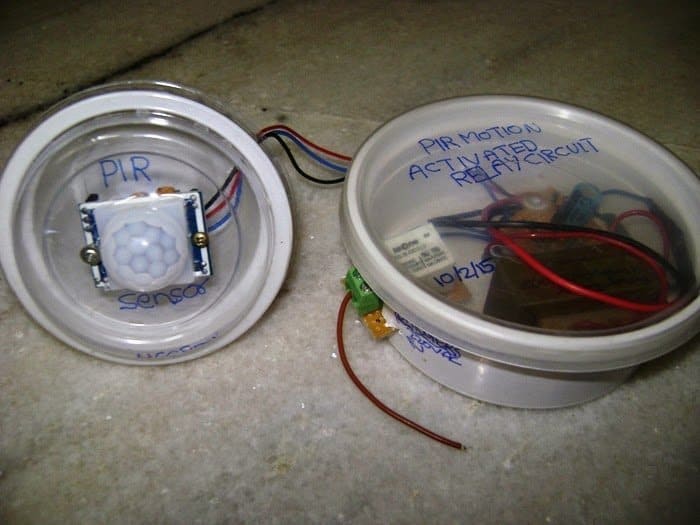
After completing the construction of the circuit, enclose it in a suitable casing and use a separate casing for the sensor and connect the sensor to circuit using long wires so that you can place sensor at the place you wish like in a garden and circuit will be inside so that the circuit is protected from weather.
And remember to use a separate PCB for relay.
Also, don’t forget to use a suitable relay with correct current and voltage rating. You can use a terminal block which connects to the relay’s switching contacts, and arrange it as shown in image so that you can change the electrical device connected to relay contacts easily.
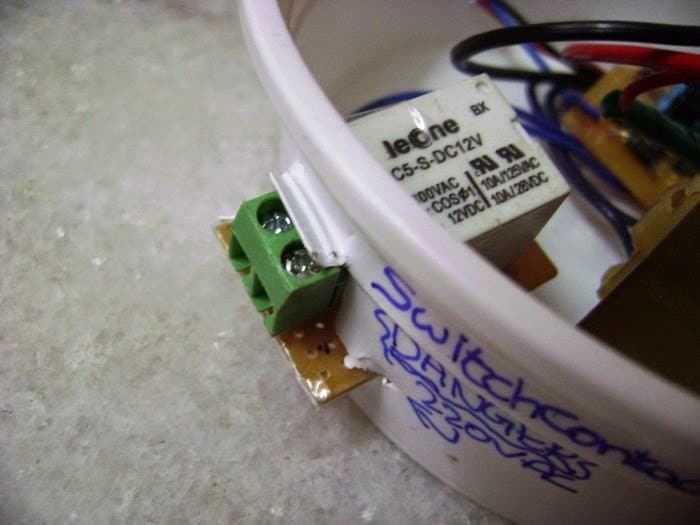
Usage of this sensors save electricity to great extents. It could reduce your electricity bills too!
“PLEASE SAVE THE POWER FOR THE NEXT HOUR!”
If the above PIR moving human detector design is intended to be used with an alarm and a lamp such that both the loads operate during night but the alarm only during day, then the diagram may be modified in the following manner. The idea was suggested by Mr. Manjunath
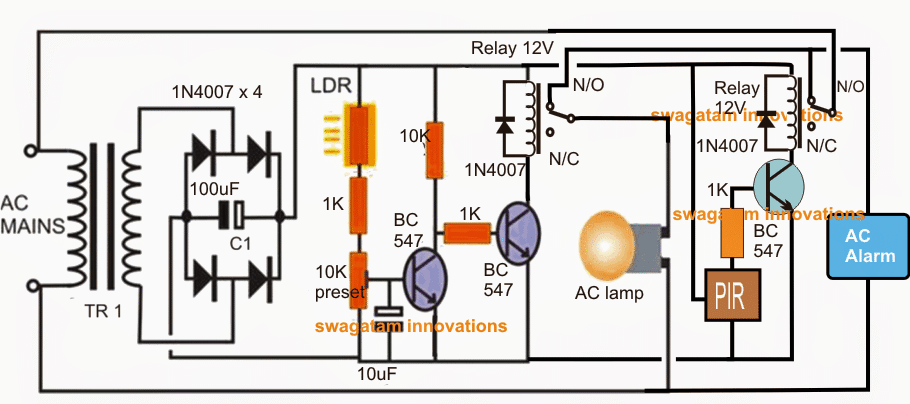
5) Industrial Application
The 5th circuit diagram below shows an industrial motion sensor circuit using a couple of LDRs, an IC and a few other passive components. The circuit senses the movement of a cylinder illuminating the appropriate LEDs for the required detection. The idea was requested by Mr.Hasnain.
Technical Specifications
I have sent you request on Google account, i am not sure that you got my messages or not, so i am sending you my problem here again, please help me out i shall be very thankful to you, i hope you will understand my problem and solve it...
sir it is related to motion sensing, and i have no knowledge about sensors, that which type i should use..problem : there are two levels, ( level means height), level A, and level B. height A > height B.i want to use sensors at these levels, so from now i will say sensor A and sensor B..
i have two indication lights RED and GREEN there is a cylinder that moves from up to down and then down to up and so on..first it will move from up to down and will come in front of sensor A.
( at this time RED light should turn ON and GREEN turn OFF) and moving downward cylinder will come in front of sensor B.
( this should make no difference, i,e RED should remain ON, and GREEN should remain OFF ).
then cylinder will start moving upward, first it will move away from sensor B.
( at this time RED should turn OFF and GREEN turn ON), then moving upward cylinder will move away from sensor A,
( this should make no difference. i,e RED should remain OFF and GREEN should remain ON)..then again repeat.
The Circuit Design
The proposed idea is quite straightforward and can be understood with the following points:
When power is switched ON, the IC is reset through the 0.1uF capacitor ensuring the green LED illuminates first.
At this position both the sensors sensorA (LDR1) and sensorB (LDR2) are able to receive the lights from the relevant laser beams focused at them.LDR1 switches ON BC547 transistor while LDR2 does the same for BC557 and keeps it triggered.
Due the above actions the transistor BC557 passes the supply voltage to pin#14 of the IC. However since LDR1 ad BC547 are also conducting this potential gets grounded, and the net potential at pin#14 remains at logic low or zero.
Now as the cylinder lowers and comes in front of LDR1, it blocks the beam making LDR1 resistance high, shutting OFF BC547.
This allows the voltage from the BC557 to hit pin#14 producing a forward sequence at the output of IC which results in illuminating the red LED and shutting off green LED.
The cylinder continues its downward motion and comes in front of LDR2 blocking its beam and lowering its resistance, this stops the transistor from conducting such that the potential at pin#14 of the IC is again switched back to zero, however this action does not effect the IC since it's specified to respond only to positive pulses.
Next, the cylinders reverts and starts moving upwards and in the course unblocks the LDR2 beam allowing the BC557 to conduct, and yet again the positive pulse from the transistor is allowed to hit the IC pin#14 resulting in the restoration of the previous situation i.e. now green LED illuminates and the RED shuts off.As the cylinder moves past LDR1, BC547 also switches ON, but produces no effect due to the same reasons as explained above.
The above motion detection cycle keeps repeating in response to the specified cylinder movement.
Circuit Diagram
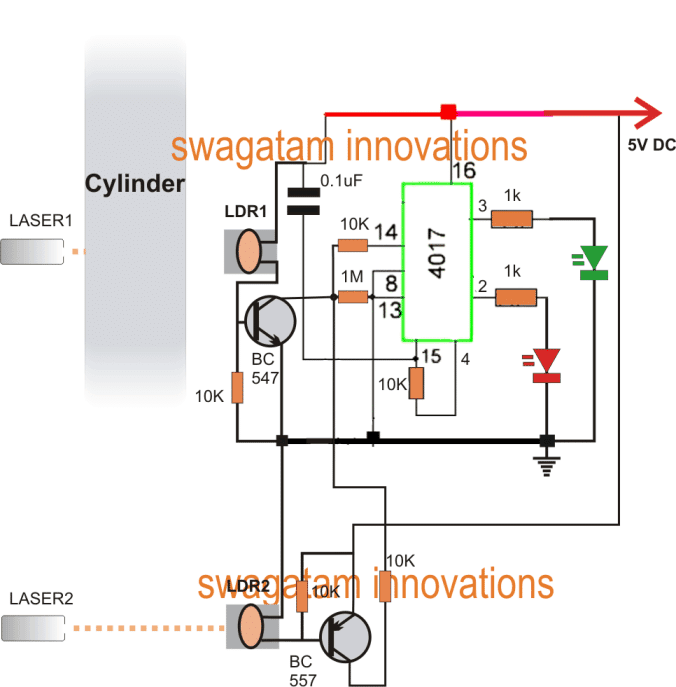
PIR Security Alarm with Delay Effect
When the PIR is triggered, the BC547 switches ON which in turn prompts the TIP127 to switch ON. However, due to the presence of the 220uF capacitor the base emitter voltage of this PNP transistor is unable to attain the required 0.7V quickly, and the LED does not light up until the 220uF is fully charged.
When the PIR is switched OFF, the 220uF is able to quickly discharge through the 56K resistor, rendering the circuit in a standby position quickly. The 1N4148 diode ensures that the circuit works only as a delay ON PIR circuit and not as a delay OFF.
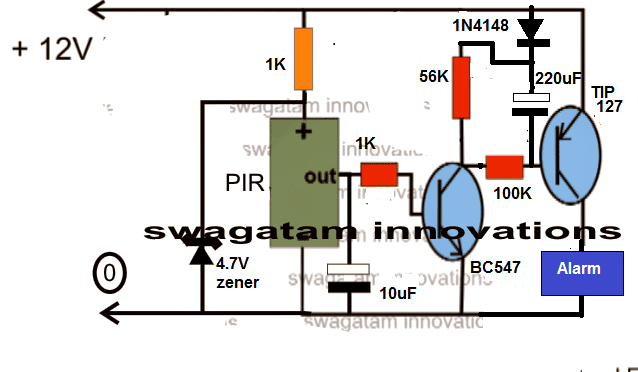
Can’t wait to say how grateful and excited stumbling on to this site has made me. I will make a time to return as I have an allied question: How does the wireless connection and message encoder system work for wireless PIR’s when there is more than one to learn?
Thank you for your feedback, I am glad this site helped you, however currently I have no information regarding How the wireless connection and message encoder system work for wireless PIR’s.
I will keep looking for it and update in case I find anything useful….
Hi,
I have an RE200B PIR sensor, and I was able to get it working by connecting a 1nF capacitor and a 100K ohm resistor. I also have a transistor and an op-amp for amplification, but I’m finding it difficult to design an amplifier circuit that properly amplifies the output from my RE200B sensor.
Since this is my graduation project, understanding how to build the amplifier circuit would make a huge difference. Is there a tutorial video that explains how to do this on a breadboard?
Any guidance would be greatly appreciated!
Hi,
A single BJT should be enough to amplify the RE200B sensor output for the IC 741. If you are still having difficulty in toggling the BJT, you can modify the BC547 with two BJTs configured in Darlington mode and check the response.
Can you give me a circuit diagram for it please
You can try it in this way: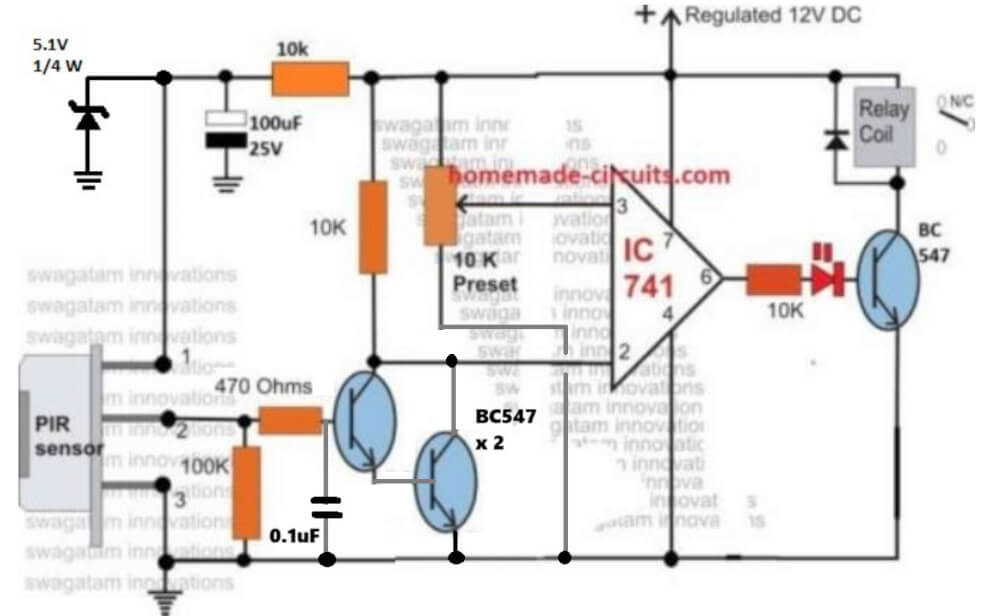
" rel="ugc">
Hey sir, greetings from Brazil! I have a question regarding the first section, but first a bit of background. I am by no means an engineer, I am simply a college cs student, so my knowledge of electrical engineering is very, very, limited. I have bought a PIR sensor (specifically the ZRE200GE but without the fresnel lens) and I have bought a few op amps and transistors for this project. My goal is just to illuminate the shoe room of my house, so it doesn’t have to be anything fancy. My questions are: can I complete this project without using a fresnel lens since accuracy is not of the highest order? How would I go about connecting a PIR sensor to an Arduino? Would I only need the PIR sensor, op amps, transistors, and wires?
Thanks again for your time, you must be a very busy man!
Hey Eduardo,
Yes you can try the following design without the fresnel lens, although in that case the circuit could become too sensiitive.
" rel="ugc">
If you are having the correct Arduino code then you can use it with the sensor without the lens. In that case the opamp circuit might not be needed.
Just always make sure to connect a high value resistor of 2k—-10k in series with the (+) input of the sensor, to limit the current to the sensor and prevent false triggering of the circuit.
Hi Swagatam,
I found a mistake on my PCB. It is now working fine. Thanks for your quick response!
That’s good Norman, Glad it is solved now!
Hi Swagatam,
I have a 501 PIR circuit that turns on a 5v cooling fan. The cooling fan is actually turned on and off by a 555 monostable. I bread boarded the circuit and it works perfectly. I PCB’d it and the PIR never turns off. Any ideas as to why the PIR never turns off. I tested two different 501 PIRs on the bread board and both work perfectly. When installed on PCB they never turn off.
Hi Norman,
Please try adding a 1k resistor in series with the Vcc supply of the PIR and check the response.
Let me know if it works or not?
Dear Sir , You always deserve the thumbs up for very fast and correct reply. I keen to know that your circuit design:
2) PIR Motion Detector and Security Alarm CircuitUpper of that page . Is it possible to remove relay and directly connect a 12v Siren here to make this circuit cost Savings .
Thank you Jobayer,
Yes, that’s possible. You can replace the BC547 transistor with a TIP122 and activate a siren directly between its collector and the positive supply.
dear sir…
i was trying to replace variable resister on PIR module HC-SR501 for distance….unfortunattly silver coated is removed and unable to find path…please guide me where i can connect VR for diatance
thanks
Hi Ghulam, can you please check the PCB and tell me where the 3 contacts of the VR are leading to, for example IC inputs, transistor base, ground or Vcc etc?
sir i tried but couldnot found the path, timer VR is ok, only distance VR coated removed,
Sorry, but without knowing the components associated with the VR it is impossible to tell the exact connections of the VR tracks.
Hello, how to adjust circuit no.1 so that the PIR only responds at night?
Replace the IC741 pin2 resistor with 100k resistor, replace IC741 pin3 preset with a 100k preset.
Connect an LDR between pin3 and ground of the IC741.
If you find the circuit too sensitive consider reducing the 100k resistor value across the PIR sensor pinouts.
Hi sir Salute to your spirit
Sir I have 36 solar panels and recently there are solar panels robberies in our area so I want you to take out your valuable time and set up a circuit for me which is perfect in all respects. And perfect for thieves of all mindsets
I eagerly await
I Will do
Sorry for weak English
Thank you Swasti,
There are a few options, such as vibration sensor, motion sensor, and PIR sensor.
You have posted another comment on another post, so I will try to specify the one which is more appropriate under that comment.
Sir engineer Swagatam
I recently purchased a PIR sensor. when I searched for a circuit diagram on your website to find and assemble a circuit to alert me if a cat comes down from the tree into the yard where my pigeons live, I noticed that it’s shape, and all components are exactly the same as the one that you have published a very good article about: SR501 ( https://www.homemade-circuits.com/pir-sensor-datasheet-pinout-specification-working/); along with a circuit diagram, and that you have referred one of your visitors to the second circuit which is composed of one S8050 or BC547 transistor and a relay. A customer reported that it works with 5 to 12 volts but it is better to use 5 volts.
would you please confirm if this circuit would be suitable for my needs?
yours truly
Ersa
Thank you Ersa,
I guess you are referring to the following design:
" rel="ugc">
I have tested this circuit myself thoroughly with 12V and did not find any problems with a 12V DC and a 12V relay.
However you can also try a 5V supply with a 5V relay, it should still work.
Just be careful with the pin connections of the transistor since 8050 pinouts are exactly opposite to a BC547 pinouts.
Thank you very much dear Swagatam. I hope it will react to the Cat the same as human beings. God bless you.
You are most welcome Ersa, Yes a cat should be detected since a cat also radiates body heat in the form of infrared emission, just like a human being.
Dear Sir Swagatam
Hello. Hope you are healthy. It is working well. Thank you for publishing this excellent circuit.
Truly yours
Ersa
Thank you Dear Ersa, for updating the information. I am so glad it is working for you. Please keep up the good work.
Hi Swagatam,
In my house, I have installed the HC-SR501 PIR modules with a relay modules to activate the lights during the motion detection in 10 different places in my house. After some days/months, I noticed the false trigger in some of the PIR modules modules. Some modules are keep on fluctuating between high and low, and some modules are always in high only. Then I replaced them with the new PIR modules and the cycle repeats the same like working good for some days/months and giving problem after that. Am not able to find out the solution for this problem. So now I decided to make a own circuit with IC555 as monostable (for timer) integrating with core PIR D204S. But am not able to integrate PIR D204S with IC555 to activate the relay. So I tried your first circuit from the above but no luck. And also Am confused on choosing the correct core PIR for my circuit.
1. Kindly suggest which core PIR from the below three I can use for my purpose, or suggest me a correct one from your side.
D204S
PIR Sensor G2x2
D204B
2. How to integrate the core PIR with IC555 monostable to activate the relay.
Kindly help.
Hi Sriram,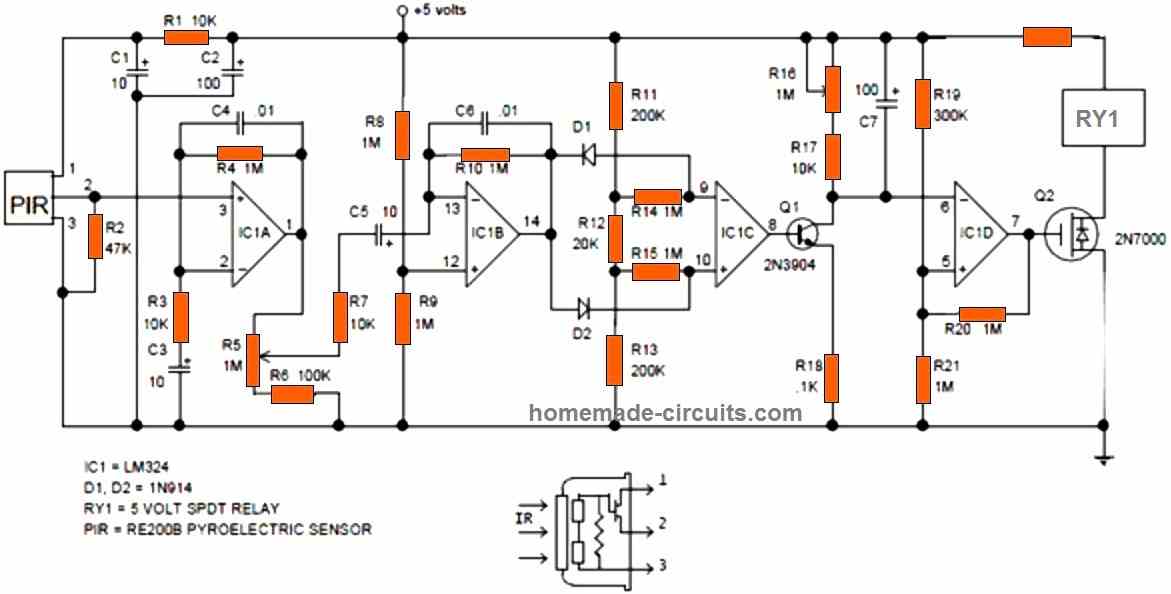

Please do not try the PIR without the fresnel lens it will give you lots of problems, because it is highly sensitive and can produce erratic results without the lens. Moreover the core PIR module cannot be integrated with a 555 monostable directly. You will need the following elaborate circuit to make it work correctly.
" rel="ugc">
Instead you can make the following circuit, this has been thoroughly tested by me, and it works without any issues.:
" rel="ugc">
Please note that an 8050 has been in the schematic, if you BC547 the emitter collector pin connections will be opposite
Thanks you for the suggestion. Will try on that.
No problem.
Dear Mr. Swagatam!
I have a PIRMINI-SR505 sensor. I need a circuit which give a short pulse anytime when anybody approach the sensor. The length and the frequency of the pulse is not important. I want to use this pulse to reset a counter or drive a Latch.
I hope you can help me.
Thanks.
Your Hungarian reader: Federics István.
Thank you Federics,
You can try the following design, it should do the job for you.
" rel="ugc">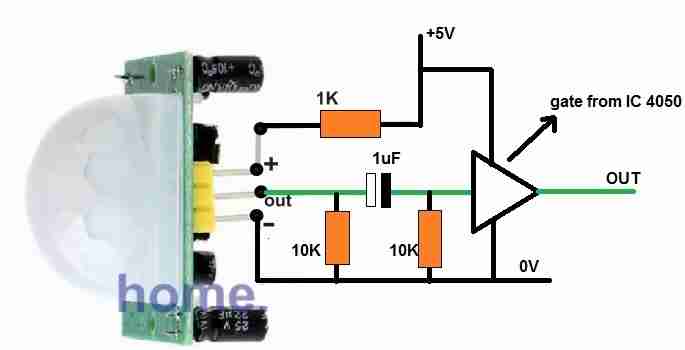
One further Question, What is the number of the Ready Made PIR module in No 2 so that I can locate it to purchase several’
Many thanks for your help
Athol
The number is HC-SR501
Can I use your first or other circuits in the following application. Sensor to turn on a low voltage motor then turn it off when the person has walked passed and continue in this manner as more people pass by. This is in a daylight situation only.
Yes, you can do it.
I would recommend circuit 2) which is a fully tested:
" rel="ugc">
Très fantastique. Merci infiniment pour tes efforts. Ahmed du Maroc
You are most welcome!
Your tutorial is fantastic.i enjoyed the PIR circuits detailed diagrams
Thank you!!! Glad you found it helpful.
where can i find a li-ion battery charger circuit
12 volt dc battery
5 to 8 amp charging with auto cutt off
You can refer to the last relay circuit from the following article. Replace the relay with a 12V relay, and use a supply Dc that suits your battery.
https://www.homemade-circuits.com/usb-automatic-li-ion-battery-charger/
Dear Mr. Swagatam,
Thank you so much for these innovative tutorials. I’ve a critical interest ( obsession) in electricity. I want to learn from the scratch. May you please give me your contact WhatsApp or. And also I was wondering that from where do you get those electric circuit components, I meant , for instance, Like the resistors, PIR, LED etc.
Many Thanks, your response has been appreciated very much!
Thank you Emmanuel,
I understand your requirement. If you have any queries or doubts you an ask them through comments, I will try to solve them for you.
i want to build a water drinking bowl for my dog where water will flow in the bowl when she approach the bowl. my vision is for the small fountain supplying water will start and stop after may be 5 seconds (adjustable) of approaching. good enough to give something to drink.
You can use the following idea, but I wouldn’t recommend an external delay feature because the PIR module itself has a delay adjustment feature. The relay contacts can be configured with a 12V water tap solenoid.
Hello, I am looking for information regarding the HC-SR501 circuit board. There are 2 places that have
1/10th inch spaced plated solder through holes. I didn’t find any label markings related to them except the shape of the copper around the holes, the square and round. I am guessing they might be for an LED. Any guidance or reference about these might be helpful and appreciated
Thanks, Doug
Hello, I don’t think the board includes an LED. You can refer to the last diagram from the following article which shows a similar design, you can compare your PCB track layout with this design and try to figure out the exact purpose of those pads.
https://www.homemade-circuits.com/pir-sensor-datasheet-pinout-specification-working/
I tried to make the first one on breadboard with the pir D203S but it didn’t work.
Maybe I should change something e.g. resistances;
You can try the second diagram which is easier to implement.
Hello Swagatam. Thank you for all your work to teach us and answer everybody’s questions.
I use trail cameras to photograph animals in the wild. I am wondering if it is possible to have pir a longer distance from the camera (maybe 20-50 meters)? I have built your circuit and conected it to one of my cameras and it works great. Now if I can just extend that connection?
Thank you in advance Ravi G
Thank you Ravi, Glad you could built the circuit successfully! I am actually not very sure about the maximum range of a PIR, but you can probably try enhancing it by removing the fresnel lens from the PIR. This could make the device extremely sensitive and in turn increase its range to the desired levels.
Hi, I am working on a UVC LED disinfecting device that consist of 12 V DC fan, an led series/parallel array, and a constant power LED driver (Meanwell elgc-300-h-ab) with 110 AC input and default output of 5.6 A and constant current region output voltage of 29 V ~ 58 V rated for 256 W. The LED array consist of 28 LEDs rated for 9W each and max current of 0.8 A. My question is how I can include a PIR sensor to turn off the LEDs when it senses human motion for safety purposes. I would love to hear any ideas to help get me started, I don’t know how to go about wiring these components together, I would preferably like to create a device that requires a single receptacle plug in, therefore I might need more parts such as a relay or converter, perhaps it would be easier to use an AC PC fan, I have many uncertainties. please let me know if you can help in any way thank you!
Hi, I can help you with the PIR switching circuit. The design shown in 2) can be suitably modified and used for your application, as shown below:
I have built the first circuit on your list.
But I have found a problem with the sensor, it uses two sensors within and compares the two before putting out the difference on the output pin.
So if you place a Infra Red Source in front of the sensor it sends out nothing, as both sensor see the same IR source, and the sensor is still balanced!
You have to cover one of the sensor pads with plastic tape to get it unbalanced, i.e. comparing it with no IR signal, then it will react to a IR source and provide a output without any movement.
Also the inputs to the OP amp have to be reversed, otherwise it turns OFF when the IR source is detected.
Then you can detect a human hand or face with a sensitivity of nine inches to three feet.
The infrared source must move so that both the sensors inside the PIR can sense the movement and produce an alternating voltage at the output. If the source remains stationery the PIR cannot sense anything. Your suggestion is incorrect, PIR can never sense an IR if it is stationery. Either the source has to move or the PIR has to move, if both remain stationery, nothing will be detected.
You cannot cover any part of the PIR.
The op amp inputs are correctly configured so that the op amp output goes high when the PIR produces an AC pulse in response to a human movement. If you reverse the op amp input pins, the relay will be always ON and will be switched OFF only when a IR source is detected, which we don’t want.
Sorry your wrong, because I have done it!
Covering up just one of the sensor windows produces an output when a IR source is stationary.
No movement necessary to get an output.
It also changes dependent on the distance between the sensor and the source. You can adjust the sensitivity using the potentiometer.
If what you are saying is true then why this is not implemented in all the PIRs? Why they have made the detection process so complex using two channels inside the lens? Why the manufactures have made it compulsory for the detection to happen only when the target is moving?
Because the main reason for having a PIR is to detect movement!
It is then used in intrusion detection, street lights etc.
But it does not work if the movement is vertical, or constantly in front of the sensors, as it only outputs an UNBALANCED voltage.
I have sent this in as a suggestion to the company concerned, as I have seen on the internet a lot of failures of projects due to this problem, especially when trying to program a computer to recognise the output.
It is currently NOT a PIR device, but a PDIR Passive Dynamic Ifra-Red device which relies on movement, not just IR.
By using just one sensor you get what you want, an IR detector, giving you an output proportional to the strength of the incoming IR beam, no matter what direction it comes from (obviously this is effected by the design of the sensor at an angle).
The sensitivity can be adjusted to operate an alarm at a certain distance, if you know the source of the IR. So it can be used to eliminate small animals for instance.
So does it mean your method will not detect a moving human being. If it will, then using the two sensing elements doesn’t make sense. The manufactures should have employed your method which looks much convenient and straightforward? It actually looks too good to be true. You must post a video on this, on Youtube.
Hello,
Can I get your email to contact you regarding one device?
Hello, You can discuss it here!
good night sir Im looking for a wireless ac voltage detector , if can help
I will check it and let you know soon
Dear Swagatam,
I have tried differently in 2-3 ways constructing PIR motion sensor. all gave satisfactory results. But when temperature difference occurs due to wind flow it gives false alarm randomly. If you have any suggestion to overcome this problem, it will honour me.
Dear Soubhik, glad the circuits are working for you, however, that sounds strange, because the PIR might trigger ON only when there’s significant amount of difference in temperature around it. I have tested it with ceiling fan running at full speed, and did not see any such false triggering. You can try reducing the input supply to 5 V and check if that solves the problem. Use 12 V only for the relay separately.
Good day! Im just a student and i would like to ask about the circuit analysis of PIR Human Movement Detector Circuit using Op Amp. where does the comparator get it’s reference voltage? How does the op amp output trigger the alarm?
Hello, It is already explained in the article itself, under the diagram.
I mean the specific value of reference voltage sir
Reference will need to be set by adjusting the 10k preset
Creative and i have not published an depth analysis of PIR detectors and smoke detectors, if you are interested we can be in touch
Why you do not use operative amplifiers, good results can be achieved and more
Hello Swagatam,
Just wanted to let you know, I have been scouring the internet looking for something that would work for an idea I have. I have been having problems with deer, raccoons and bear causing me problems. First, I looked for something that would already do what I had in mind. And, there are a few devices that deal with these animals, but nothing that did exactly what I had in mind. So, I decided to try and design a circuit that would help me. I know very little about electronics, but I knew what the circuit needed to do. I just couldn’t get it to work. Then, I came across your site, and after a couple of tries it worked. It is based on your circuit #2. When I get the final product, I will send you a video, so you can see what it does. I think you will find it interesting. Thanks again for your willingness to share your expertise and knowledge with guys like me.
Thanks Billy, I am glad the circuit helped you achieve the required results.
You can certainly send the video to me, it will be a pleasure to watch how you succeeded with the project.
Hi Swag,
I am having a hard. It works fine on breadboard. Not good on pcb. This was my first attempt at soldering on a pcb. Any recommendations on getting from breadboard to pcb? Are there any multimeter tests on the pcb that could isolate the problem? I can see myself going thru a number of pcb’s and components trying to get this right.
Hi Billy, Use the PIR Module with the transistor directly soldered on the PIR pin, and assemble the rest of the elements like the resistor, and the relay on the PCB, and check if that works.
There are no crucial meter based troubleshooting tips for this project.
Hi Swag, I built the circuit as in the diagram right after “2) PIR Motion Detector and Security Alarm Circuit” but instead of a siren I have a night light.
Is there an easy way to add components to make sure the circuit doesn’t get triggered in daylight and only at night ?
Thanks in advance !
Hi Andy, it can be easily done, by adding the following circuit to your existing PIR circuit:
…the transistor can be another BC547
Awesome Swag, thanks for your quick reply !
Glad to help, Andy!
We have a UV-C lighting tower and would like to add a switching circuit that opens and delays restoring power to the lighting ballasts when humans (human body) are present to prevent exposure to the harmful UV-C rays. I would like to construct and install PIR sensors on the four sides of the tower. All the circuits I’ve seen depict the use of a single PIR sensor. Can four PIR sensors be connected in parallel with any one triggering the relay? Is there a diagram of such a device or can an isolation resistor or other device be used? Is there any such item available “off the shelf”? Thanks for all help and advice.
Yes you can use any number of PIR with a single drive circuit. You can apply the 2) concept, and connect all the PIRs in parallel using the following shown approach
Please do the above shown wiring across all the PIR modules, and then connect the shown 1,2,3 points together in parallel. The 1. terminal common end associated with the 1k will go to the positive supply +12V, the 2. diode common end connections will go to the drive circuit input, and the 3. terminal common ends will join with the negative line of the supply.
Hey Swagatam,
I still have an older hard copy of your PIR circuit for 1) with 5V, now I see you set it to 12V. Any good reason? Already buliding the 5V version…difficult to go to 12 now…
Also, clicking on that picture, you get an image without the diode on pin 6 of the IC. Any reason for that or is it just an oversight?
Many thanks!
Miguel
Hey Miguel, Yes the diagram had some problems, I have corrected it now and have replaced it with a new one, please check it now.
Many thanks, Swagatam!
You now upgraded the IC voltage to 12V, an issue for me since I have all on 5V. What is the real reason 5V should not be used? If not recommended, could I use a DC-DC converter for the IC and leave the relay and PIR on 5V?
Also, my PIR’s output is a series of pulses, so, since you are now not integrating them with a capacitor at the output of the IC as before, the relay will “see” these pulses. Why not leave the capacitor? The pulses are very short, so I doubt the relay will actually switch.
Best regards
No problem Miguel. 5V can be also used, but 12V looks better since a 12V relay will consume 50% less current than a 5V relay and will be more economical.
To ensure that the transistor does not get disturbed by the train pulse, you can simply add a 100uF/25V capacitor right across the base/emitter of the driver transistor.
Hi Swagatam,
Ok, I tried your suggestion. It works! Sorry for misunderstanding your reply. I used the circuit you suggested and replaced the supply connection to the emitter of the PNP transistor T2 with the output of the PIR and removed the relay and connected the input trigger of the music chip to the collector of transistor T2. I used a 1M resistor for R2 and a 470uF capacitor for C2. R1, R3, and R4 remain the same as your circuit. I’m using 5v supply so I removed the 3.3v Zener Diode. I tried it with the Zener and it didn’t work. I may try it again as the timing is around 35 seconds. I’ll play with it some more before making the PCB. Breadboards are sometimes hard to work with as they sometimes give bad results due to loose connections. Anyway I am happy with the circuit. Thanks so much!
I am glad it worked Norman, please keep up the good work!
Hi Swagatam,
Maybe I misunderstood your suggestion. In the example circuit T2 transistor is connected to the positive rail at its emitter and its collector is connected to relay coil which is connected to ground. Are you saying to replace the emitter connection with the output from the PIR and replace the collector connection with the trigger input of the music chip? If T2 will operate like this, it will probably work. I’ll try this and let you know.
" rel="ugc">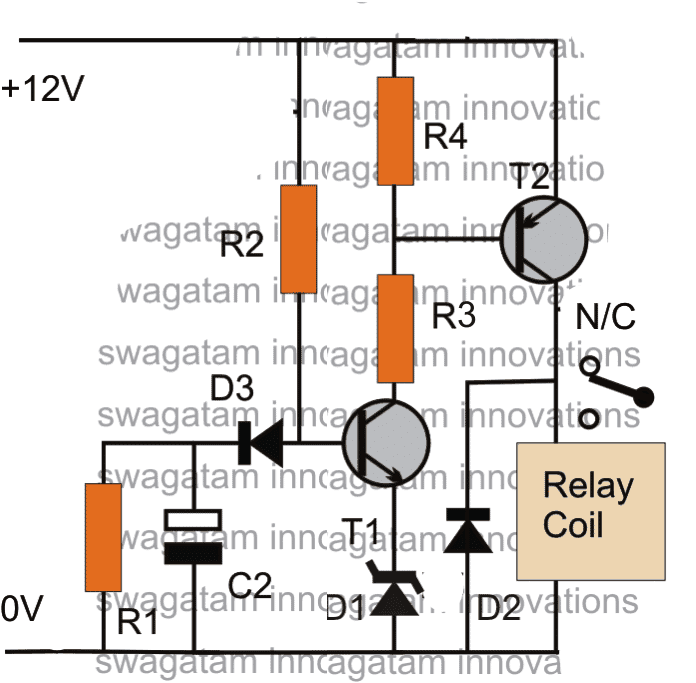
Hi Norman, You actually understood it correctly. So if you want only the PIR output to delay, in that case you can simply disconnect the R2 end from the positive line, and connect it with the PIR OUT pin. And yes you should remove the emitter zener and replace it with a direct link.
That will work to delay the PIR but I only want to delay the PIR output. If I delay the power to the PIR, then when it does receive power, it will output immediately and act irrational for up to 60 seconds. That is what I am trying to avoid. I want to interrupt the output 3.3v signal for about 60 seconds. I am using the PIR signal to play an edge (trigger) activated music chip. When I first turn on the power switch, I do not want the chip to be activated. After about 60 seconds, the PIR will be settled in and will not be putting out a signal. When a human nears the PIR, it will activate and send a signal to the trigger of the music chip which will cause the music chip to play its music.
I could use your suggested circuit to delay a relay for 60 seconds which would give the PIR the needed time to settle in. Once the delay period is over the relay contacts will be made and will be waiting for output from the PIR. This will work, but the relay takes up a lot of room on the PCB. Is there another way to interrupt the PIR output signal(similar to the relay concept) for a 60 second time interval? I could possibly use a 555 on delay, but here again the PCB gets bigger. I was hoping I could use transistors or mosfets and capacitors to achieve the desired results. As you know these little music chips are very sensitive. Thanks!
Hi Swagatam,
When you first power up a HC-SR501 PIR it outputs and sometimes is irrational for the first 60 seconds. I am trying to design a circuit to delay or interrupt the output from the PIR for about 60 seconds after power up. After the 60 second delay, the PIR should work as usual. I know I can do it with a time delay and a relay, but that takes up too much room on the PCB. Is there a way to accomplish this with transistors?
Hi Norman, I think you can try applying the circuit titled “Delay ON Timer Circuit Working Details” under this post:
https://www.homemade-circuits.com/simple-delay-timer-circuits-explained/
You can eliminate the relay and connect the PIR circuit across the collector/ground of the PNP
Hi Swatagam
I would like to have a circuit diagram of the pir switching on a room light, staying fully on , until the person leaves the room and then it switches off the light.
Thank you.
Hi Moboy, it is already given in the above article, you can use the security alarm circuit for the same purpose
Hi Swatagam,
Thank you so much for your prompt reply, I really do appreciate it.
The thing is I don’t have the same pir model as the one you are using.
But I will attempt to construct as per your suggestion and i will give you feedback. Thank you.
No problem, even with some other PIR you will still have 3 pinouts, designated as +, – and OUT…so you can configure the 1K and the transistor accordingly, as per the diagram.
Hi Swatagam
I managed to purchase a pir sensor,
constructed it like your circuit diagram and it works very well.
Thank you so much and I must say i enjoy reading and learning on your website. Your site is so very informative and instructive and professional.
Once again thank you so much for your time and effort.
Thank you moboy, I am so glad you could make the circuit successfully, keep up the good work!
Great website and lots to learn and try out. Im new(ish) to the hobby and the usual format is I try a project and it usually doesn’t work then I spend a few days going over it and a growing number end up working. Can someone who built the project on breadboard post a few pictures so I can compare?
My project (the first one of the four) lights the led on switching on but the relay will trigger randomly.
Ive gone over it and re built it several times but still the same. Any help appreciated, thanks
Thanks, and glad you are learning from this website.
piR are difficult to control, that is true. When I tried testing a PIR module, I simply couldn’t stop the PiR from continuously operating the relay, it kept on switching it ON/OFf no matter whether a human was present or not.
I checked the soldering, the wiring, any possible leakages, everything seemed alright and it seemed there was no solution to the issue.
Then I decided to remove the PCB and mount the parts directly on the PIR pins, the moment I did this the PIR started working perfectly.
Here’s the set up which worked perfectly at one go:
" rel="ugc">
Thanks Swagatam I will give that a try. I’m sure I’m not the only one here to appreciate your time and generous sharing of information. All the best Kev
You are most welcome Kev!
Hello, can I have some circuit through which I can use this pir module as bistable, like for washroom light. It should remain on until the pir sensor again detect a human. I want to install it at gate of washroom so that when a person gets in, the light switches on and remain on irrespective of time and switches off only when the person leaves the washroom. I tried using ic 4017 but not getting results. The 4017 circuit is not getting activated with the output of PIR module. Pls suggest some circuit. Thanks
Hello, a bistable is not required for this, you can simply build the 2) design explained in the above article for your specific application. It will do the job perfectly.
Hi swagatam,
Is there a way to change the blockage time of PIR ? By Blockage time i mean the time duration while PIR outputs LOW even if there is motion detected.
Hi Shrey, if you see the circuit diagram of a standard PIR, you may find a few RC networks in it, as can be seen in the last image from this article:
https://www.homemade-circuits.com/pir-sensor-datasheet-pinout-specification-working/
In this diagram there’s a capacitor C5, I guess this capacitor may be responsible for the delay effect, and could be tweaked to decrease the block time.
Hi, While am searching to buy a PIR radial, I found two part number. They are D203S and RE200B. Could you suggest me which one to buy. I am planing to integrate with 555 monostable circuit.
Hi, I would recommend buying a whole PIR module instead of the sensor, because managing the sensor sensitivity can be quite a headache
HI.. I have a question regarding powering PIR through 12V supply where you have used 1K ohm R.
PIR uses 5V to bias which leaves 7V to drop over the 1K resistor while using a 12V SMPS. Using Ohm’s Law 7V/1k = 7mA current in the circuit. Now, here, since PIR module requires 65mA driving current which is way less than 7mA. How is the PIR getting the rated current?
Please correct me where i am wrong.
Hi, If it would be 65mA, my circuit wouldn’t have worked, so it is wrong. The actual working current of a PIR sensor is no more than 200 uA, and working volatge is 3.3 V through an internal 3.3 V regulator IC.
I have used this unusual workaround since the PIR simply failed to respond when a 5V supply was applied from a rectified 12V SMPS. After lot of experimentation I could find this idea of using a 1K series resistor, and by mounting (soldering) the BJT and the resistor right over the pins of the PIR module, and finally the PIR started responding correctly
Hi Swagatam, thanks for replying.
The PIR worked absolutely fine with the resistor in Series and I did measure the current drawn by PIR (VCC) which was 67-70 microAmps (I wonder why it is advertised with low current rating of 65mA, probably there is a misprint of milli instead of micro).
Also, there was zero current reading on the Output of PIR when i drove the gate of a MOSFET through it (would you like to explain why was that?).
Another question regarding current rating of any device. let say i have a Distortion pedal that is rated 9V 200mA and I have a 9V 2A SMPS to drive it. So, is there a chance of risking the pedal by driving it with a higher current output capable SMPS or the pedal will draw only the required 200mA and be just absolutely safe with it.
Thanks Shrey, I am glad the PIR worked correctly for you. Yes you may be correct with your assumption regarding the working current of the PIR. A MOSFET gate has an infinite impedance, which means the MOSFET will not draw any current from the PIR while switching ON, and this may be the reason for the low current reading. The pedal will safely draw 200 mA only regardless of the SMPS high current, but only as long as the voltage from the SAMPS is correctly matching the specification of the load at 9V, and not exceeding this value
Hi swagtam, i have aome questions. I take out the por sensor from the pir module.
1. How to check the pir sensor wether it ok or not?
2. As per ur 1st diagram i have connected 100k from source to ground and 4.7k from sorce to bc547, emmitter to ground and connected led at +5v and collector also gave 5v to gate of sensor. Now the led only light on. Not off when there is no human movement. Is my circuit ok or the pir sensor damaged.?
Pls let me know.
Hi Chandrashekhar, PIRs are very sensitive devices, and can get triggered by any external stray signal or even by a minute disturbance in the supply source itself.
I would recommend not to remove the sensor from the module rather use it with the module and connect the transistor directly on the module as shown in the
security alarm circuit.
Dear Swag,
You are a blessing to our generation ,hobbyists and Electricians mostly.
I want to construct a coil counting machine using a fan motor whereby the motor will rotate with a piece of sq or rectangular wood for counting the coil on it.
Please can you help me design a sensor circuit which can sense a piece of metal placard welded to the rotor and send the signal to three digit counter circuit for display.
That is, whenever the placard passes or blocks the sensor it energizes its circuit to count with speed as the number turns increases from one.There will be reset.
Thank you so much.Looking froward to your reply.
Thanks Patrick, you can try the last concept presented in the following article;
https://www.homemade-circuits.com/optocouplers-working-characteristics-interfacing-application-circuits/
Dear,Sir Swagatam
Could you please help me for explaining for the control circuit and components
which used in self sterilization gates , it used in entrances of airport (for example), sterilization by certain chemical powder – the gate when sensing human body automatically open the powder to make sterilization
Hello Muhamad, do you want the gate control circuit?
Very nice tutorial. Thank you!
Thanks, Glad you liked it.
Why do you use a 25V capacitor and not a 16V?
Because 25V is more easily available than 16V, and their size and cost are same.
Thanks. So it’s maybe better to say “minimum 16V”, no? 😉
for 12V supply it must be 25V as per rules, but 16V will also do!
Is it possible to connect 4 or more hc-sr 501 pir in different zones to activate one relay? If possible how can I connect them?
Yes, that’s definitely possible, you can add any number of PIRs in parallel for activating a common relay circuit.
Please sir, can u help me with a circuit diagram of a electronic water fountain ( indoor water fountain for decoration).
I need the timing, lighting and melody diagram. Thanks
Please explain more about timing, lighting, and melody, if possible I’ll to help
Tanks for your perseverance.
My pleasure!
Thank you
Hello sir.I’m connecting the pir sensor to 12v battery and immediately gives 3.3v at output while testing it alone and I’m connecting pir and it immediately gives output to switch relay.what is problem of the sensor?Can i collect it?please answer me i want to do it faster.
Hello David, A PiR sensor is designed to detect IR waves from human presence, so while connecting the device it might be detecting the IR from your hand or body and getting activated, you must ignore the initial switch ON and connect it normally, once connected you may get aside from its sensing zone and then you may see the relay switching OFF
PIR particularly the hc-sr501 has an initialization period. Its output goes high upon connecting to a power source and remains high depending on the duration set via the onboard potentiometer. In my observation if you set the pot for longer duration, the initialization and output becomes high for several minutes and then will enter standby mode. BY the way sir swag can you help me how to set up two pir sensor to drive a single relay? Thanks!
Thanks dodong for the information, appreciate it!.
Driving a single relay through two PIRs is actually very easy, you just have to modify the diagram shown in the following article by connecting the OUT pins of the two PIR though separate 1N4148 diodes with the 1K end of the transistor base resistor. The +/- pins of the PIRs can be connected with the supply lines of the circuit:
https://www.homemade-circuits.com/automatic-pir-controlled-fan-circuit/
Hi, how could I handle two pir to activate a single relay?
My idea was to put a pir on the outside of one door and the other on the inside, so that when it enters it activates and when it leaves it goes out.
If I place only one on the outside or inside side after a while it turns off and the ideal is to stay on until you leave the room.
What I want is to turn it on when it comes in and goes out when it comes out.
Thank you for your help it would be very useful to help me make the circuit.
Hi, you can do it in the following manner: